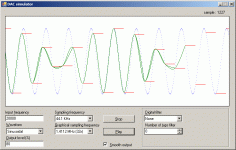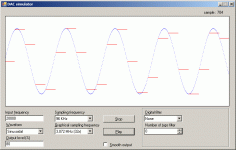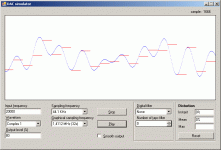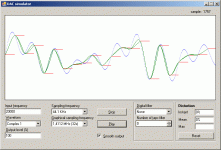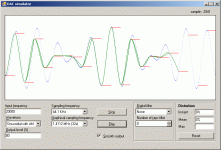Band-limiting is routinely demonstrated to reduce foldback products to well below measurability. This was an important issue in the sorts of high-accuracy FT measurements I used to do, but the issues were well-characterized. These days, steep filters are pretty trivial to implement to arbitrary accuracy. You can argue phase issues, but even granting the potential audibility, the phase is a simple Hilbert transform of the amplitude (minimum phase) and can in principle be recovered nearly perfectly- much more perfectly than in a bandwidth-limited analog system like tape or vinyl that also suffers from uncontrolled resonances (e.g., tip-vinyl).
Are you trying to suggest that humans can hear above 22KHz? Perhaps it's possible, but definitely not the average case.That doesn't address the band-limited requirement.
Otherwise any intermodulation effects would occur prior to the ADC and the resulting (audible) harmonics that would be generated would be captured in the digitized signal. For capture, high sample rates are more important since it's pretty likely the result will be mixed/scaled/processed afterwards and it's good to have the extra headroom. For playback though it's not necessary, unless you're suggesting that we can perceive sounds above the nyquist limit for the format you're discussing.
There isn't. Your plots don't show the requisite interpolation (it seems to be linear interpolation between samples), and thus don't represent what the actual output of the DAC would look like. Sampling theorem defines how to properly interpolate the samples to achieve perfect reproduction (in a practically impossible manner, but the math is proven) using an infinite sum of sinc functions. Using a lowpass filter effectively achieves the same goal, if you accept that it is imperfect (filter slope can't be infinite and passband response can't be perfect).I'll have to have a look at your other arguement because i've a feeling there is a gotcha you are missing.
Assuming Audacity is generating the proper samples, if you looked at the actual output of the DAC on a scope while playing these, you should see a perfect sine at the requested frequency, ignoring DAC error.
error401 said:Are you trying to suggest that humans can hear above 22KHz?
We may not be able to detect simple continuous sinusoids that high, but it is pretty trivial to show that information much higher than that can be a factor and research is starting to back that up.
dave
there is a good paper on exactly these issues in audio coding:
http://www.meridian-audio.com/w_paper/Coding2.PDF
for best results skip to end to look over graphs/illustrations, jump forward forward for text/discussion - repeat cycle
http://www.meridian-audio.com/w_paper/Coding2.PDF
for best results skip to end to look over graphs/illustrations, jump forward forward for text/discussion - repeat cycle
Hi,
Since we use NOS DAC, we knows that using digital filter with high tap digital filter is no sense! It introduce audible distortion (like echoes). Since sampling frequency is 44.1KHz, NOS DAC introduce big distortion too!
To easily understand digital filter I'm making a DAC simulator where I can adjust many parameters. On the picture, blue dot are input signal, red points are real points digital filter output, green curve is hypothetic low pass filtered output signal.
Eric
Nyquist theory only be reach with periodical signal and ideal digital filter. This hypothetic digital filter would have infinite taps filters to compute signal. Even modern technology don't reach this goal.error401 said:...I'm not a practical expert on this either, but the theory is quite clear - with a sampling frequency greater than twice the signal bandwidth, the signal can be reproduced exactly. As far as I understand, modern DAC technology comes quite close to realizing this, to the limits of the quantization depth used.
Since we use NOS DAC, we knows that using digital filter with high tap digital filter is no sense! It introduce audible distortion (like echoes). Since sampling frequency is 44.1KHz, NOS DAC introduce big distortion too!
To easily understand digital filter I'm making a DAC simulator where I can adjust many parameters. On the picture, blue dot are input signal, red points are real points digital filter output, green curve is hypothetic low pass filtered output signal.
Eric
Attachments
Let me just throw out this snippet from an EE professor....
dave
However, note that because the signal sample has finite length, it must (1) either have
an infinite frequency spectrum, or (2) represent a periodic signal. Since the signal is finite
length and, as a result, has an infinite bandwidth unless periodic, a digitally sampled signal is
either (1) undersampled (i.e., sampled below the Nyquist rate) or (2) we must assume that it
actually represents a sample period of a periodic process (which can then be bandlimited).
In either case the sampled signal may not exactly represent the original physical process
being sampled. Note that if we assume that the signal is not periodic (and is therefore
not bandlimited, but undersampled) we can run into theoretical difficulties applying signal
processing algorithms. On the other hand, assuming the signal is periodic can simplify the
analysis and processing. These ideas are the fundamental concepts behind the application
of the Discrete Fourier Transform (DFT) in real-world signal analysis.
While we are ultimately interested in analyzing the underlying process for which our
signal is a sample we must keep in mind the limitations of our observed signal. A sampled
(discrete) signal which is both band- and time-limited must be interpreted as a sample
interval of a periodic signal. Thus, the signal may not represent the underlying process
exactly; however, given the signal we are forced to make this assumption. While this may
have negative conotations for modeling our underlying process, it can also be used to our
advantage in processing the signal.
dave
Eric Juaneda said:As say SY and error401, with only 88.1KHz or 96KHz sampling frequency you don't need interpolation.
Eric
Hence why the interpolation is implied in any modern DAC. Did anyone mention NOS DACs, I might've missed it? This is ancient technology that has awful performance compared to modern devices, but if that's what we're talking about, the output filter is likely going to be the deciding factor in the DAC's accuracy.
planet10: Good blurb, but as far as I can tell it's basically just re framing the the critical Nyquist criteria in perhaps a more digestible fashion. If bandlimiting is applied (which it must be), there's no requirement that signals be 'periodic' in the traditional sense for them to be reproduced properly if the criteria are adhered to, since this limitation is exactly what the bandlimiting requirement addresses and really is exactly what sampling theorem is about (ie. if we have an infinite bandwidth signal, it defines what information must remain after sampling it at a certain rate).
I think we can agree that even if human hearing or secondary effects can extend beyond 22KHz, there is a finite limit to this. Once we reach that limit, bigger isn't going to be any better, as far as anyone can tell. If that is what you're asserting, I have no problem with that assertion in principle, I just wasn't sure that's what you were saying. I was under the impression you were suggesting that either it was desirable to not band limit the signal, or that band limiting had a significant effect on the signal in the passband (which I've already mentioned is the main reason for increasing sample rate).
error401 said:I think we can agree that even if human hearing or secondary effects can extend beyond 22KHz, there is a finite limit to this. Once we reach that limit, bigger isn't going to be any better, as far as anyone can tell. If that is what you're asserting, I have no problem with that assertion in principle, I just wasn't sure that's what you were saying.
I think we are pretty much on the same page. In the context of audio, 44 kHz is not sufficient to fool our ears into thinking it is an analog signal.
Based on the math, at the time i was studying the subject & i was totally on top of it (senior stats course) and syncronystically the same time Sony released their CD white paper (a couple years before the 1st CD players were released), i said that sampling rates needed to be at least 4x higher to overcome the inherent limits of sampling music in the real world. That seems to be being bourne out by recent hi-rez developments.
dave
Hi error401,
Eric
First CD player was NOS DAC and some last CD player or external DAC converter were NOS DAC too! You can find many example in this forum or to some manufacturers. On 1996, Ryohei Kusunoki wrote an interesting article about distortion introduced by digital filter : Non-oversampling, Digital filter-less DAC Concepterror401 said:...NOS DACs [...] is ancient technology that has awful performance compared to modern devices
Interpolation was introduced to reduce complexity of analog low pass filter and reduce phase shift who could be introduced by this complex analog filter. Shifting complexity to digital filter who need to compute interpolation within, at least, DAC resolution 0.00015% for 16bit or 0.0000059% for 24bit....Hence why the interpolation is implied in any modern DAC.
Analog or digital, output filter is very important....what we're talking about, the output filter is likely going to be the deciding factor in the DAC's accuracy.
Eric
SY said:
It works, period (bad pun). Anything with a frequency sufficiently close to the Nyquist frequency will be a sine wave once it's passed through a low pass filter since the harmonics fall above the Nyquist frequency. Multiple sine waves of varying phases near the Nyquist fequency are no problem and no exception to the theorem.
I can imagine the full reconstruction of the signal works if the "filter" is a fourier analysis of the complete signal and all harmonics above fs/2 are left away. Then the signal is a sum of continuous sines.
Did you ever see an image that was filtered that way? Looks horrible and is only done to demonstrate it doesn`t work.
Hi Sy,
What do you mean, why do you need dither?
Eric
SY said:...With a sampling frequency greater than twice the signal bandwidth, the signal can be reproduced exactly...
That's exactly right. No interpolation needed. And with proper dither (not at all difficult), there's no resolution loss at a finite number of bits, just a degradation of S/N.
What do you mean, why do you need dither?
Eric
Hi,
that graph in post25 has striking similarities to the 20kHz graph in post17.
Who is going to shout down two bits of software that suggest the sampling of simple sinusoids is very difficult when the sampling rate is slightly more than two times the frequency.
How bad can it get when there is a varying frequency?
What happens when two frequencies are present in the signal?
What if both those frequencies vary in amplitude?
44.1ks/S sampling rate is just not enough. 96ks/S is better. Why can't we just jump straight to 192ks/S? We have the technology.
What do they use in the new HD DVD format?
The 16bit level is similarly inadequate. 20bit is much better. But we should be insisting on at least 22bit to maintain resolution of low level signals and low level variations in the signal. 24bit seems to be just too low for affordable technologies at the moment. But at least record the data at the best achievable resolution. The reproduction will eventually catch up.
that graph in post25 has striking similarities to the 20kHz graph in post17.
Who is going to shout down two bits of software that suggest the sampling of simple sinusoids is very difficult when the sampling rate is slightly more than two times the frequency.
How bad can it get when there is a varying frequency?
What happens when two frequencies are present in the signal?
What if both those frequencies vary in amplitude?
44.1ks/S sampling rate is just not enough. 96ks/S is better. Why can't we just jump straight to 192ks/S? We have the technology.
What do they use in the new HD DVD format?
The 16bit level is similarly inadequate. 20bit is much better. But we should be insisting on at least 22bit to maintain resolution of low level signals and low level variations in the signal. 24bit seems to be just too low for affordable technologies at the moment. But at least record the data at the best achievable resolution. The reproduction will eventually catch up.
Hi Andrew,
I don't think that we really need 192K, 96K seem to be enough (It is a personal point of view).
Recording studio works since a long time with 96KHz 24bit resolution. Working with 24 ADC don't mean that you have real 24bit resolution.
I never understand why CD are not recorded to 0db, since recording studio works with 24bit resolution? Lossless adjustment would be very easy.
Eric
YesAndrewT said:That graph in post25 has striking similarities to the 20kHz graph in post17.
I make my software simulator to see what append on theses situations. (see attached sample picture)Who is going to shout down two bits of software that suggest the sampling of simple sinusoids is very difficult when the sampling rate is slightly more than two times the frequency.
How bad can it get when there is a varying frequency?
What happens when two frequencies are present in the signal?
What if both those frequencies vary in amplitude?
Technology is ready an standard exist since DVD exist! DVD-A standard 96K 24bit and 192K 24bit exist since DVD Video exist. There is only few disc available. More disc on SACD (DSD) format are available, certainly because it is more difficult to copy.44.1ks/S sampling rate is just not enough. 96ks/S is better. Why can't we just jump straight to 192ks/S? We have the technology.
What do they use in the new HD DVD format?
I don't think that we really need 192K, 96K seem to be enough (It is a personal point of view).
The 16bit level is similarly inadequate. 20bit is much better. But we should be insisting on at least 22bit to maintain resolution of low level signals and low level variations in the signal. 24bit seems to be just too low for affordable technologies at the moment. But at least record the data at the best achievable resolution. The reproduction will eventually catch up.
Recording studio works since a long time with 96KHz 24bit resolution. Working with 24 ADC don't mean that you have real 24bit resolution.
I never understand why CD are not recorded to 0db, since recording studio works with 24bit resolution? Lossless adjustment would be very easy.
Eric
Attachments
Hi,Eric Juaneda said:I make my software simulator to see what append on these situations. (see attached sample picture)
can you add the green plot showing the filtered output?
Can you simulate one of the frequencies with varying amplitude?
CDs are already fully modulated. Many look like they have been over recorded.Eric Juaneda said:Recording studio works since a long time with 96KHz 24bit resolution. Working with 24 ADC don't mean that you have real 24bit resolution.
I never understand why CD are not recorded to 0db, since recording studio works with 24bit resolution? Lossless adjustment would be very easy.
I don't think we are capable of doing 24bit at the commercial level yet. I think they can do about 22bit in the recording studio.
We certainly cannot get 24bit from a chip and probably can't get 22bit either.
If we could all afford discrete circuits, then 22bit (-132.4db) would be achievable. Have you calculated what 24bit requires with a standard 2Vac signal? The lowest resolution step is just 0.12uV (-144.4db) I don't think my DVD player can get noise that low never mind resolve a signal at that level. CD cannot even look at numbers like that. The second step is @ 0.24uV, that is a jump of 6db from first bit to second bit. Does that sound like it mimics the analogue data that is being sampled?
Eric Juaneda said:Hi Sy,
What do you mean, why do you need dither?
Eric
Dither is necessary to avoid both amplitude and time quantization error. It converts errors of time and amplitude resolution to errors of noise. For example, if you have an undithered sine wave that drops in amplitude, at a certain point (at the LSB) the sine wave suddenly vanishes. With dither, you hear a little more hiss than before, but you can hear the sine wave even as it drops below the supposed resolution limit of the system- sort of like analog tape.
Properly implemented (which just isn't that hard to do), 16 bit gives you all the S/N you could use in a home environment. That's a different question than what is necessary for handling the signals at the recording/processing end or internal to the playback unit.
preiter said:Why are more bits/ higher sampling rate better?
Invalid question.
Hi Andrew,
Here it is.
AndrewT said:...can you add the green plot showing the filtered output?
Here it is.
Attachments
AndrewT said:...Can you simulate one of the frequencies with varying amplitude?
Yes.
Attachments
Hi,
thanks Eric.
Two simple tones at below sampling rate/2 and the output from the DAC is nowhere near the input that was sampled.
What happens when the input is more complex?
or my original question: How bad can it get?
It's what has been said for more than two decades.
The Sony/Philips 16bit 44.1ks/S standard "perfect sound forever" is inadequate.
thanks Eric.
Two simple tones at below sampling rate/2 and the output from the DAC is nowhere near the input that was sampled.
What happens when the input is more complex?
or my original question: How bad can it get?
It's what has been said for more than two decades.
The Sony/Philips 16bit 44.1ks/S standard "perfect sound forever" is inadequate.
- Status
- This old topic is closed. If you want to reopen this topic, contact a moderator using the "Report Post" button.
- Home
- Source & Line
- Digital Source
- Why are more bits/ higher sampling rate better?
